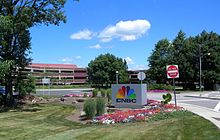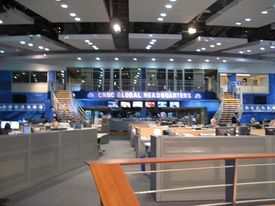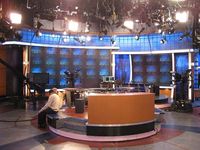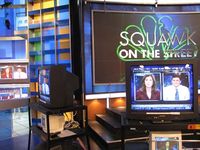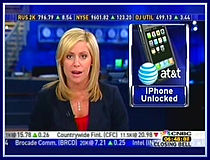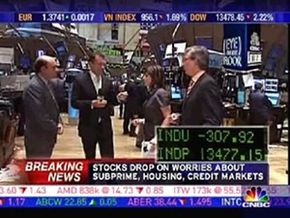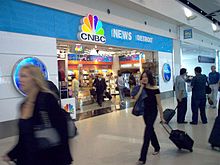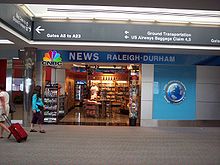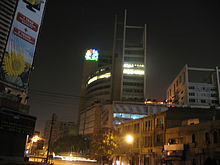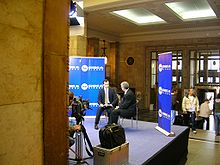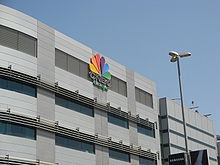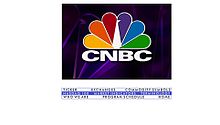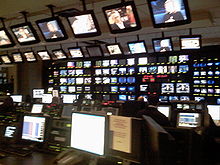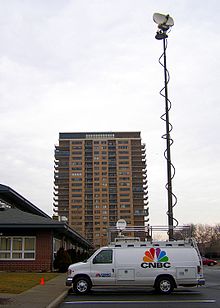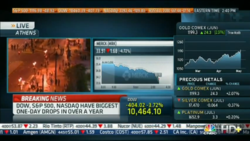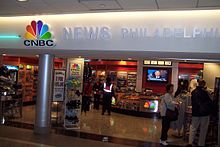- CNBC
-
Coordinates: 40°53′55″N 73°56′21″W / 40.89861°N 73.93917°W
This article is about the business news channel in the United States. For all international CNBC channels, see List of CNBC channels. For other uses, see CNBC (disambiguation).CNBC 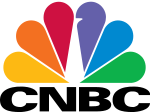
Launched April 17, 1989 Network NBC Owned by NBCUniversal Picture format 480i (SDTV)
1080i (HDTV)Slogan "First in Business Worldwide" Country United States Language English Broadcast area United States
CanadaHeadquarters Englewood Cliffs, New Jersey, United States Sister channel(s) CNBC World
MSNBC
NBC
Weather ChannelWebsite CNBC.com Availability Satellite DirecTV (U.S.) 355 (SD/HD) Dish Network (U.S.) 208 (SD/HD)
9439 (HD)C-Band AMC-10, Channel 101
(Transponder 13)Shaw Direct (Canada) 504 Cable Available on most US and Canadian cable systems Check local listings for channels In-House (Washington) Channel 13 Verizon FiOS 102 (SD)
602 (HD)Satellite radio Sirius 112 XM 112 IPTV AT&T U-verse Channel 216 (SD)
Channel 1216 (HD)Bell Fibe TV (Canada) Channel 509 Internet television CNBC Plus (US$9.95/month or US$99.95/year)[1] RadixTV 21[2] CNBC (officially the Consumer News and Business Channel until 1991)[3] is a satellite and cable television business news channel in the U.S., owned and operated by NBCUniversal. The network and its international spinoffs cover business headlines and provide live coverage of financial markets. The combined reach of CNBC and its siblings is 390 million viewers around the world. In 2007, the network was ranked as the 19th most valuable cable channel in the U.S., worth roughly $4 billion.[4] It is headquartered in Englewood Cliffs, New Jersey.[5]
History
The CNBC channel originally had its beginnings around 1980 as the Satellite Program Network (SPN), showing a low-budget mix of old movies, instructional and entertainment programs. The channel later changed its name to Tempo Television. After initially signing a letter of intent to acquire Tempo,[6] NBC eventually opted for a deal to lease the channel's transponder in June 1988.[7] On this platform, and under the guidance of Tom Rogers, the channel was relaunched on April 17, 1989 as the Consumer News and Business Channel. NBC and Cablevision initially operated CNBC as a 50-50 joint venture,[8] choosing to headquarter the channel in Fort Lee, New Jersey.
CNBC had considerable difficulty getting cable carriage at first, as many providers were skeptical of placing it alongside the longer-established Financial News Network. By the winter of 1990, CNBC was only in 17 million homes - less than half of FNN's potential reach – despite having the muscle of NBC standing behind it.[9]
However, around this time, FNN encountered serious financial difficulties. After a protracted bidding war with a Dow Jones-Westinghouse Broadcasting consortium (the former's assets would be used to build a rival channel almost two decades later),[9] CNBC acquired FNN for $154.3 million on May 21, 1991 and immediately merged the two operations, hiring around 60 of FNN's 300-strong workforce.[10] The deal increased the distribution of the newly enlarged network to over 40 million homes.[10] Cablevision sold its 50% stake to NBC upon completion of the deal.[11] With the full name "Consumer News and Business Channel" dropped, the network's business programming was at first branded "CNBC/FNN," although this was phased out before the mid-1990s.
Under Rogers' leadership, CNBC began to grow during the 1990s, launching Asian and European versions of the channel in 1995 and 1996 respectively.[12] In 1997, CNBC formed a strategic alliance with Dow Jones, including content sharing with Dow Jones Newswires and The Wall Street Journal and the rebranding of the channel as "a service of NBC and Dow Jones".[13] CNBC's international channels were then merged into a 50-50 joint venture with their Dow Jones-owned rivals, London-based EBN (European Business News) and Singapore-sited ABN (Asia Business News) in 1998,[14] while ratings grew on the U.S. channel until the new millennium's dot-com bubble burst in 2000.[15]
The new millennium also brought changes to the network, moving its world headquarters from Fort Lee to Englewood Cliffs, New Jersey in 2003, which features completely digital video production and studios made by PDG Ltd of Beeston, Nottinghamshire and the FX Group of Ocoee, Florida.
NBC Universal reacquired full control of loss-making CNBC Europe and CNBC Asia from Dow Jones at the end of 2005. The licensing agreement between Dow and CNBC U.S. remained intact, however.[16]
Today, CNBC provides business news programming from 4 a.m. to 8 p.m., Eastern Time, while broadcasting talk shows, investigative reports, documentaries, infomercials, and other programs during the evening and early morning. A rolling ticker provides real-time updates on share prices on the NYSE, NASDAQ, and AMEX, as well as market indices, news summaries, and weather updates by NBC Meteorologists (prior to March 27, 2006, all of CNBC's weather reports were provided by AccuWeather). A rotating top band of the screen rotates provides real-time updates on index and commodity prices from world markets.
CNBC is the only NBC network whose abbreviation, while containing NBC, stands for another name: the Consumer News and Business Channel. The moniker was simply shortened to CNBC when the former was dropped.
Programming
See also: Category:CNBC programsPresent shows
CNBC provides a variety of programs throughout the business day presenting reports on U.S. businesses, updates of stock market indices and commodities prices, interviews with CEOs and business leaders, and commentary from many investment professionals. The following is the usual "business day" (term used by CNBC hosts and announcers) lineup (as of February 26, 2009 all times Eastern):[17]
ET Program Hosts Description 4a-6a Worldwide Exchange Ross Westgate, Christine Tan first word on movements on futures exchanges and trading in Europe and Asia 6a-9a Squawk Box Joe Kernen, Rebecca Quick, Andrew Ross Sorkin provides a mix of business news and commentary 9a-12a Squawk on the Street Carl Quintanilla, Melissa Lee, Simon Hobbs, Jim Cramer, (live from NYSE), David Faber, Gary Kaminsky broadcasts live from above the New York Stock Exchange trading floor 12:00p-1p Fast Money Halftime Report Scott Wapner fast-paced review of stocks for short-term trades at the mid-point of the trading day 1p-2p Power Lunch Tyler Mathisen, Sue Herera, Melissa Francis, examines the companies, people, and trends influencing Wall Street, plus real-time market coverage at the midway point of the trading day 2p-3p Street Signs Amanda Drury, Brian Sullivan focuses on trends, world events affecting stock markets, and real-time market coverage 3p-5p Closing Bell Maria Bartiromo, Bill Griffeth (for the 3-4pm hour) covers the close of the trading day and real-time market coverage 5p-6p Fast Money Melissa Lee (host), Pete Najarian, Guy Adami, Tim Seymour, Karen Finerman (panelists) fast-paced roundtable discussion of stocks for short-term trades 6p-7p Mad Money Jim Cramer a fast-paced show offering stock advice to callers, interviews with guest CEOs, and discussions on the technical details of the stock market. 7p-8p The Kudlow Report Lawrence Kudlow provides market, economic and political commentary and interviews 8p-11p CNBC Specials various anchors special business documentaries and reality television programs Since 17 September 2007 the network has also run hourly CNBC.com News Now update segments during business day programming. These short bulletins, which are around 30 seconds in length (similar to ESPN's SportsCenter Right Now), air before the start of the network's programs from Squawk on the Street through The Kudlow Report.
CNBC has experimented with non-business programming during primetime hours with a mixed record of success, including a talk show hosted by Dennis Miller. The channel has at times rebroadcast several NBC programs, including Late Night with Conan O'Brien, Deal or No Deal, The Apprentice, The Apprentice: Martha Stewart, and 1 vs. 100. CNBC's current primetime lineup features The Big Idea With Donny Deutsch, re-airs of NBC programs The Apprentice, Deal or No Deal and 1 vs. 100, along with its own documentaries and talk shows including Mike on America, American Greed and Conversations with Michael Eisner. Prior to 20 April 2006, programs in primetime hours were shown with a 'scroll' featuring news headlines and weather updates at the bottom of the screen.
Infomercials are typically aired from 2 am to 4 am ET and throughout most of the day at the weekend. Since the September–October 2008 financial crisis, the network has begun to place a paid programming bug on the top right corner of the screen during all airings of infomercials.
On January 24, 2007, the network launched a long-anticipated monthly newsmagazine called Business Nation, which is anchored by award-winning journalist David Faber. Each edition of the program covers three stories; a mixture of profiles, investigative pieces and features. The format of the show is structured similarly to HBO's Real Sports.[18]
CNBC's breakout hit among its original series is Mad Money. Hosted by money manager Jim Cramer, the hour-long show gives stock advice to viewers who call to the program. The show also has a popular segment called "The Lightning Round". In August 2007, Cramer's on-air tirade about the weakening economy, which was seen during the "Stop Trading" segment on Street Signs, received national attention and helped galvanize widespread support for the Federal Reserve Board to cut interest rates.
Other special or weekend programming includes CNBC on Assignment (for example, The Age of Wal-Mart), Cover to Cover, The Suze Orman Show, On the Money, The Wall Street Journal Report with Maria Bartiromo. CNBC Originals have included Marijuana Inc: Inside America’s Pot Industry, Trash Inc: The Secret Life of Garbage, and Supermarkets Inc: Inside a $500 Billion Money Machine.
In May 2010, CNBC announced that it would be adding business and financial-themed movies to its Friday night lineup under the name "CNBC Cinema."[19]
Past shows
Among the shows that have been canceled are:
Weekdays
CNBC weekday schedule history (1996 - present)
The following only lists programs that CNBC mostly broadcast at that timeslot at that year (for at least half the year), "♣" denotes no regularly-scheduled program at that time:
ET 1996 1997 1998 1999 2000 2001 early 2002 mid 2002 2003 2004 2005 2006 early 2007 mid 2007 late 2007 ET 04:00 Sponsored Programming European Market Watch Morning Exchange Worldwide Exchange 04:00 04:30 This Morning's Business Early Today 04:30 05:00 Asia Market Wrap Today's Business: Early Edition Today's Business Sponsored Programming Wake Up Call 05:00 05:30 Before the Bell 05:30 06:00 Today's Business Wake Up Call Squawk Box 06:00 07:00 Squawk Box Squawk Box 07:00 08:00 Capitol Gains Squawk Box Squawk Box 08:00 08:30 Squawk Box 08:30 09:00 Squawk on the Street Squawk on the Street 09:00 10:00 The Money Wheel Market Watch Morning Call 10:00 11:00 Midday Call The Call 11:00 12:00 Inside Opinion Power Lunch Power Lunch Power Lunch 12:00 12:30 Power Lunch 12:30 13:00 Power Lunch 13:00 14:00 The Money Wheel Street Signs Open Exchange Street Signs 14:00 15:00 Street Signs Closing Bell 15:00 16:00 Market Wrap 16:00 ET 1996 1997 1998 1999 2000 2001 early 2002 mid 2002 2003 2004 2005 2006 early 2007 mid 2007 late 2007 ET 17:00 Market Wrap Business Center Business Center Kudlow & Cramer Kudlow & Company Fast Money 17:00 18:00 Business Insiders Bull Session The Edge The Edge Business Center Bullseye Mad Money 18:00 18:30 Business Tonight The Edge Business Center Checkpoint CNBC 18:30 19:00 The Money Club Business Center The News with Brian Williams Capital Report Late Night On the Money Kudlow & Company 19:00 19:30 Steals and Deals [20] Great Stuff [21] Upfront Tonight The Edge 19:30 20:00 Politics Equal Time Hardball with Chris Matthews Kudlow & Cramer The News on CNBC / ♣ ♣ Fast Money 20:00 20:30 Equal Time Hardball 20:30 21:00 Rivera Live America Now Capital Report Dennis Miller Dennis Miller / Mad Money Mad Money ♣ 21:00 22:00 Charles Grodin Late Night / The News The News with Brian Williams McEnroe The Big Idea 22:00 23:00 America After Hours Charles Grodin Hardball with Chris Matthews Kudlow & Cramer The News on CNBC / ♣ ♣ Mad Money / On the Money Mad Money 23:00 ET 1996 1997 1998 1999 2000 2001 early 2002 mid 2002 2003 2004 2005 2006 early 2007 mid 2007 late 2007 ET Weekly, weekend and other programming
- National Geographic Explorer (moved to MSNBC and then to the National Geographic Channel)
- Louis Rukeyser's Wall Street (ended its run on New Year's Eve 2004 at Louis Rukeyser's request)
- Market Week with Maria Bartiromo (renamed After Hours with Maria Bartiromo and then Special Report with Maria Bartiromo -- cancelled in 2004)
- Tim Russert (moved to MSNBC)
- American Le Mans Series races (inaugural 1999 season only, as part of agreement with NBC Sports)
- PGA Champions Tour
- The Big Idea with Donny Deutsch
- Management Today
- How to Succeed in Business
- Strictly Business
- Weekly Business
- Inside America's Courts
- CNet News.com
- Ushuaia
- Weekend Squawk Box
- Topic [A] with Tina Brown
- World Business Reports
- Consumer News
- Smart Money
- Media Biz
- Business Wrapup
- Business View
- Media Beat
- Your Portfolio
- Money Talk
- Money Shack
- Money Today
- Opinions
- McLaughlin
- Real Story
- Real Life
- Real_Personal_(TV_Series)
- The Dick Cavett Show
- Tom Snyder
- Outside the Box
Personalities and coverage
 The TV studio at the NASDAQ MarketSite, where CNBC's market updates and the show Fast Money are hosted.
The TV studio at the NASDAQ MarketSite, where CNBC's market updates and the show Fast Money are hosted.
Much of CNBC's on-air talent has been with the network for some time: Sue Herera and Scott Cohn joined CNBC at its inception,[22][23] and remain on the air co-hosting Power Lunch and as senior correspondent respectively. Some personalities who joined CNBC from FNN in 1991, such as Ron Insana, Bill Griffeth and Joe Kernen, are also still with the channel.[24][25][26] The network has of late sought to increase the profile of its on-air team with the launch of rival business station Fox Business Network - although CNBC's best known personality, Closing Bell host Maria Bartiromo,[27][28][29] has for some time made regular appearances on other NBC News broadcasts such as The Today Show and has anchored the syndicated Wall Street Journal Report, other CNBC hosts such as Jim Cramer and Erin Burnett have also been used increasingly across NBC's output.
In addition to its roster of program anchors, CNBC employs a team of reporters who contribute across the network's business day programming, the majority of whom are based at CNBC's global headquarters in Englewood Cliffs. In addition, CNBC has staff permanently based at bureaus in Midtown Manhattan, Chicago, Washington, D.C., Los Angeles and San Jose[30] (the latter referred to on air as "CNBC Silicon Valley"). Cost-cutting at NBC Universal's news divisions has seen some of these offices merged with those of NBC owned-and-operated stations:[31] the Silicon Valley facility was moved from Palo Alto to the KNTV (NBC 11) newsroom in San Jose in January 2007[32] (occasionally KNTV reporters Scott Budman and Scott McGrew will now correspond for CNBC), while the Chicago bureau now shares a home with WMAQ (NBC 5).[33] The network also has reporters posted at the New York Stock Exchange (where CNBC also has a set used for broadcasting Squawk on the Street, The Call and Closing Bell), NASDAQ MarketSite, NYMEX and the Chicago Board of Trade and Chicago Mercantile Exchange each day.
Ratings
There is a fairly clear long-term correlation between the performance of global stock markets and the audience ratings of CNBC. The network had a difficult time attracting viewers in the first half of the decade, but has seen viewership increase from a 2005 bottom to record highs in 2008, coinciding with the subprime mortgage crisis. CNBC continues to possess the wealthiest audience (in terms of average income) of any television channel in the United States.[34]
During the late 1990s and early 2000s, CNBC's ratings were increasing sharply along with the stock market, often beating those of CNN during market hours.[35] In 2000, daytime viewership of the network peaked at 343,000,[36] around the time the Nasdaq Composite crossed 5000. However, when the dot-com bubble began to burst later that year, CNBC's viewing figures declined in tandem. The network's ratings steadily fell quarter after quarter, year after year, until bottoming in Q1 2005, with an average viewership of 134,000 during the day.[37] From the bottom, the network, along with the markets, rebounded significantly—average daytime viewership (6 am to 6 pm) reached a 7-year high of 310,000 viewers in the first quarter of 2008.[34] Coinciding with the extreme market volatility of the ongoing global economic crisis, ratings hit an all time high of 416,000 in Q3.[38] Although the figures remain considerably less than those achieved by Fox News and CNN today, it has still had a 210% increase in viewership since the beginning of 2005. Despite the viewership slump at the turn of the decade, CNBC has remained extremely profitable: average annual revenues top $510 million[39] while profits for the network exceeded $333 million in 2007,[34] making CNBC a cash cow for NBC Universal and its parent company, Comcast. CNBC is the second most profitable of NBC Universal's thirteen cable channels in the United States, behind only the USA Network.[34]
The network often sees large spikes in viewership on days of major market moves. In the week of 27 February 2007, when the Dow Jones Industrial Average had its seventh-largest loss ever, CNBC's continuing coverage of events[40] resulted in its best ratings week since the market crash after the September 11, 2001 terrorist attacks, with Kudlow & Company, Mad Money, and Fast Money recording their best ratings ever in the coveted 25-54 demographic.[41] When the financial crisis wraecked havoc in the worldwide equity markets, CNBC recorded some of the highest ratings in the network's two-decade history. For the week ended September 19, 2008, the network averaged 502,000 viewers during the "business day" (defined by the network as 5 am to 7 pm). During this week, Squawk Box, Closing Bell, Fast Money, Mad Money and Kudlow & Company recorded their best viewership figures ever.[42] On September 29, 2008, when the markets faced their worst single session performance since the crash of 1987, CNBC saw its best ratings day ever, with an average 726,000 viewers tuning into the network during the business day.[43]
While daytime viewership has rebounded from its 2005 lows, primetime ratings remain weak relative to those of other news networks[44] and CNBC continues to try and rejuvenate its evening lineup. Along with developing new program formats such as Fast Money and Mad Money, the network operates a "checkerboard" programming approach, airing various genres of shows including documentaries, town-hall style discussions and repeats of some NBC output.[45]
When discussing the network's ratings, CNBC management and press releases regularly suggest that considerable viewership, particularly during the daytime, is done "out of home" in places such as offices and hotel rooms.[46][47] As this demographic is not covered by Nielsen ratings, CNBC claims that the network's true viewership is considerably higher than what is measured.[47]
On-air presentation
Graphics
CNBC is well known today for its flashy and ostentatious graphics package, complete with accompanying animations and animation-sounds. Previous graphics packages put together by the network since the early 1990s have gradually increased the "wow" factor—likely in order to catch a casual viewer's eye, as cable news competition has increased dramatically since the network was launched in the late 1980s.
On 15 November 2006, CNBC's 'crystal' gray logo bug was changed to color revealing the rainbow's peacock's normal NBC colors. On 2006-11-28, the new smaller CNBC color bug (similar to the one used in the revamped ticker) began to show up on CNBC's non-business related primetime programming (where the ticker is not shown, except Mad Money and Fast Money), replacing the much bigger 'crystal' bug.
On 1 March 2007, CNBC's Squawk on the Street and Closing Bell both started using a new countdown clock (shown in minutes:seconds:tenths-of-a-second format) on the graphics' lower-third of the screen. On 27 July 2007, it moved to the lower right of the screen, where the CNBC color bug is usually seen. The countdown clock is used for the "Opening Bell Countdown" segment on Squawk on the Street, and for the "Closing Countdown" segment on Closing Bell, along with presidential debates, the announcement of some monthly consumer indexes, and Federal Reserve Bank interest rate changes.[48]
On 2 May 2007, CNBC's Mad Money revamped its own on-air graphics package, replacing what was used—including its opening animation sequence—since the program's 14 March 2005 debut.
In November 2007, the CNBC color bug in the ticker on the lower right of the screen started rotating (and morphing) between the network logo and the CNBC.com logo and back. This is seen only during the network's "Business Day" programming.
CNBC began using the "CNBC 20" logo on January 1, 2009 on all of its programs to promote the network's 20-year anniversary. The "CNBC 20" logo was in use all throughout 2009.
First generation graphic
Used from 17 April 1989 to 31 December 1994. The bottom band of the ticker displayed various indices (such as the Value Line Arithmetic Index, shown). The network did not have a live bug tracking the various indices, nor did it have its logo fixed on the creen. Instead, camera shots of the anchors at the main desk were positioned in a way to show the "CNBC" lettering at all possible times.
The studio in the picture, right, is located in the original Fort Lee, New Jersey building. This was later completely rebuilt as part of changes introduced by the network's then president Roger Ailes.[49]
1995 revamp
Used from 1 January 1995 to 31 December 1997.
1998 revamp
This was used from January 1998 to May 1999. Majority of the lower-thirds and the live bug was coloured blue with the left side of the lower thirds and upper part of the live bug coloured red. The background for its charts was animated with majority of the background being blue and a narrow green strip running at the right side of the screen resembling a stock ticker. When the major maker indexes hit a new record, the green strip is tweaked to reflect "DOW RECORD", "S&P RECORD" or "NASDAQ RECORD." It is also tweaked during the holiday season. (Note: The image rightward doesn't contain the ticker part.)
1999 revamp: "Red" turns "Green"
The 1998 graphics scheme was slightly tweaked in May 1999 where the once red parts of the lower thirds (seen on the left of the blue strip of the lower thirds) and the "LIVE" bug's upper part turned green. The font was also modified. The green strip at this time is also tweaked during earnings season. Graphs also started having the CNBC logo was behind them and included grids. On 3 April 2000, CNBC Asia has used this scheme only for its charts but a month later CNBC Europe used it for its charts and lower thirds as well. This package was in place until 29 September 2000 on CNBC, until 31 December 2000 on CNBC Asia and until mid-January 2001 on CNBC Europe. Show titles, however, remained the same as the 1998 package.
2000 revamp
Used from 2 October 2000 to 13 September 2002. In January 2001, CNBC Asia and CNBC Europe both followed up to use the same graphic package, making some changes to the lower thirds and the charts respectively (for example, removing the animation on and off screen). This marked the first time that the three main CNBC channels had used the same graphics scheme in their entirety for all daytime shows. In February 2002, however, while most programme titles largely remained the same on the CNBC US channel, two new shows, Morning Call and Closing Bell used the titles which were originally for Street Signs and Market Watch respectively (the latter two were cancelled at the same period as well).
2002 revamp
Used from 16 September 2002 to 10 October 2003. This package saw an evolution of the graphics introduced in 2000, with program titles and chart formats remaining the same. The lower thirds were, however, completely revamped with the lower half of it coloured red and text was centre-justified, and a new background animation and colour scheme was introduced for charts and other on-screen data. The font was also tweaked. The titles in the lower thirds were centre-justified. CNBC Asia used a similar lower thirds effective 2 January 2003 except that the lower thirds was entirely light blue and the text was still aligned to the left. CNBC Europe adopted the same chart backgrounds in use by CNBC US later in 2003 as well but used a different lower-thirds.
2003 revamp
Used from 13 October 2003 to 16 December 2005. In this revamp, CNBC added an independent space to the lower thirds to show the "topic title" to indicate the subject being discussed (i.e., "money to burn" in the rightward photo). This formerly shared space with the program logo on the left-hand side of the lower thirds.
CNBC also added another animation to the lower thirds: when showing stock charts, the lower thirds would move down vertically, keeping just the "topic title" visible above the ticker. When charts were removed from the screen, the whole lower thirds would move vertically up again.
The "LIVE" sign was also moved from the left-top corner to the right-top corner, along with the location (which was formerly included on the lower thirds) at this time.
CNBC Asia adopted this graphics scheme in 2004 but on CNBC Europe's next graphics revamp in the same year, it chose to create its own graphics scheme for charts, lower-thirds and titles.
December 2005 revamp: from 2D to 3D
Used from 19 December 2005 to 12 May 2006. On 19 December 2005, CNBC unveiled a new on-air look, replacing that which had been used since October 2003. This included a new look for all the graphics, new logos for all business day programs, and the relocation of the index and commodity prices from the stacked bug in the bottom right-hand corner of the screen to the bug bar across the top of the screen.
Since then, the ticker has shown full company names (and full commodity names used in the commodity summary, which runs at the 1s of each hour) instead of just ticker symbols.
The "LIVE" and location graphics were moved back to the top-left of the screen from the top-right corner at this time.
This graphic package was created by Randy Pyburn of Pyburn Films (that also designed the WNBC's 2003 graphic package, KYW-TV's 2004 package & WPSG's 2005 package) and also designed earlier CNBC graphic packages. The estimated cost of the 2005-2006 package was about $2 million.
Mid-2006: revamped bug and lower thirds
- On 15 May 2006, CNBC made a slight change to its lower thirds, adding a blue block to the right-hand side. Occasionally this space was used to display the title of the topic being discussed. This format was abandoned on 18 December 2006.
- On 6 September 2006, CNBC unveiled a revamped bug, which now has a similar resemblance to that of CNBC Europe. On the same day, the network launched a slightly modified ticker with a narrower font (to allow more quotes to stream by within a period of time). CNBC Asia adopted a revamped bug of its own on 26 March 2007 as part of its graphics package revamp.
December 2006: new lower thirds
Used from 19 December 2006 to 26 February 2010. On 19 December 2006, exactly one year after its relaunch, CNBC revamped its on-air graphics package, replacing the old lower thirds that were previously used from 19 December 2005-18 December 2006. The current graphic package was created in-house.
In this revamp, CNBC cancelled the independent space for the "topic title", which once again shares space with the program logo on the left-hand side of the lower thirds.
CNBC Asia adopted the similar lower thirds on 26 March 2007, but unlike its US version, the "topic title" does not share the space with the program logo. Its European sibling (CNBC Europe) finally debuted its own lower thirds on 7 January 2008, and like its US version, the "topic title" shares space with the program logo on the left-hand side.
- On 23 April 2007, the data bug was slightly tweaked, with the titles of the securities now displayed in yellow and the numbers still being displayed in white.
- On 26 July 2007, the Dow Jones Industrial Average lost more than 300 points, CNBC stayed on the story and put a live shot of the trading board in the NYSE to show the status of Dow above the lower thirds during the Closing Bell to track the markets.
- (Note: The screenshot rightward comes from CNBC Asia, so the style of the top bug and the ticker are different from the package of CNBC US.)
- On 28 February 2008, the chart was slightly tweaked, when showing session is more than two days, CNBC put up the % of the session performance, just like CNBC Europe.
March 2010 revamp: almost back to 2D
On March 1, 2010, CNBC debuted a whole new graphics scheme across most of its networks, including its U.S. HD+ feed. This replaced the previous graphics package which had been used since 19 December 2005 and the lower thirds that were used since 19 December 2006. The data bug now shows the securities in white and the numbers in green (indicating up) or red (indicating down), along with triangles (green for higher and red for lower).
Ticker
The CNBC Ticker is a computer simulation of ticker tape shown on the lower part of the screen during the network's live business programming, containing security and index symbols along with movements in their value. At the top of the screen, a rotating band, partitioned into three segments, provides index and commodity prices.
History
When CNBC first aired in 1989 until approximately 1991, the original CNBC Ticker only had one band, displaying NYSE stocks. After a 20 minute period when the ticker was off-air one day, as announced by anchor Ted David, did CNBC finally decide to include the NASDAQ in a new format at the time, creating the two-band system used ever since.[50] FNN did use a two-line ticker design (with white and blue bands, quotes listed during trading without price changes and a market summary on the bottom band during trading) prior to the merger with CNBC in 1991, and many of these features were subsequently adopted by the newly merged channel. Here's an example of FNN ticker circa 1987.
CNBC had another ticker format, mainly a font variation on the ticker, for a short time before the 1995-1997 photo on this page.[50] During special events (for example, the Dow Jones Industrial Average passing 6000, 7000, etc. or another extremely impactful market event), the CNBC Ticker showed mutual funds on the NYSE band while leaving the NASDAQ band unchanged. This convention has been discontinued.[citation needed] In 1998, CNBC's ticker became more colourful with green indicating a stock price increase and red indicating a stock price decrease. The ticker now shows full company names (and full commodity names used in the Commodity Summary, which runs at the 1s of each hour) instead of just the ticker symbols, as seen before December 2005 but only the arrows remain coloured green or red.
Current graphic formats
 Typical on-air screen appearance during the business day. Used from 19 December 2006 to 26 February 2010.
Typical on-air screen appearance during the business day. Used from 19 December 2006 to 26 February 2010.The bug bar, at the top of the screen, which stays on-screen during the business day (4 am ET to 6 pm ET), will give viewers a real-time snapshot of the general stock market (Dow Jones, Nasdaq S&P 500 indices and Russell 2000 index, along with the DJ Utilities, DJ Transports and NYSE indices), international markets and futures (between 4 am ET and 9:30 am ET only), currencies, bond prices/yields and commodities. The stock market indices, global markets, currencies, bonds, yields, and commodities are displayed in yellow, with the numbers displayed in white. This data stays on for 5–7 seconds, before refreshing to the new set of data.
The bottom two lines, called the ticker, gives viewers real-time NYSE quotes (on the top band) and Nasdaq/AMEX quotes (bottom band) throughout the trading day (ticker symbols are 1, 2, or 3 letters long for the NYSE stocks; Nasdaq uses 4- and 5-letter symbols; 3-letter ticker symbols are used at the AMEX). A commodity summary is shown on the top band (every 10 minutes at 0:01, 0:11, 0:21, 0:31, 0:41, 0:51 past the hour), along with a market summary (which is shown every 20 minutes at 0:01, 0:21, 0:41 past the hour). A Nasdaq/AMEX market summary is shown on the bottom band every 20 minutes at 0:06, 0:26, 0:46 past the hour. The bottom ticker formerly showed a market summary at 0:16, 0:36, 0:56 past the hour but, it no longer does. The ticker now also provides the size of each trade (the volume, or number of shares traded), a feature which was reinstated on July 12, 2006 after it was dumped during the re-launch in December 2005.
Also, PowerShares ETF symbols, which are traded along the lower band of the ticker, are highlighted in orange for sponsorship reasons.
Before and after-market hours (8:00 am ET - 9:30 am ET and 4:00 pm ET - 6:30 pm ET respectively), the ticker gives viewers extended hours trading quotes (after-hours quotes are symbolized with gold text). Between the hours of 5:00 am ET - 8:00 am ET and 6:30 pm ET - 8:00 pm ET, viewers are shown an alphabetical recap of the closing prices of S&P 500 stocks on the top band, while latest news headlines as well as weather projections for selected cities are displayed on the bottom band.
Above the ticker, the left-hand side graphic will provides the logo for the specific program that is currently on-air (i.e., "Morning Call"). The middle block gives viewers either a caption of the topic being discussed (i.e., "Mike Huckman") or information about the correspondent on the screen. Additionally, the left block is also replaced by logos indicating general subjects (i.e., "Behind the Wheel",) or the network's "Breaking News" (gold on red), "CNBC Alert" (green), "CNBC Market Alert" (black on gold) or "CNBC Exclusive" (orange) logo when required.
Taglines
- "A Service of NBCUniversal and Dow Jones" (17 May 2004 - 31 December 2005, 2007–present)
- "Capitalize on it" (2011–present)
- "Fast, Accurate, Actionable, Unbiased" (2007–present)
- "America's Business Channel" (2005 or earlier - 2008)
- "First in Business Worldwide" (12 June 2006–present)
- "The World Leader in Business News" (2004 - 11 June 2006)
- "Make It Your Business" (2002–2004)
- "Business for the New World" (2002)[51]
- "Profit From It" (1998–2002)
- "First in Business, Worldwide" (1996–97)
- "First in Business, First in Talk" (1995)
- "Information that hits home." (1992–95)
Music
The music used from October 2003 to December 2005 was produced by 615 Music of Nashville, Tennessee. This music (though only edited versions of the arrangements for Street Signs and Closing Bell) continues as of February 2009 to be used by CNBC Europe, although CNBC Asia ceased using it in March 2007. CNBC Europe continued also to use "CNBC Anthem" a.k.a. "Bold & Grand", which was composed by Edd Kalehoff and used by CNBC US between 2000–2002. For its main channel ident used until a relaunch on 30 September 2008, the anthem was remixed, adding the NBC chimes to the music. However, it is still used for its "Europe Update" segments during US programming. The current music package is composed by James Ryan of Rampage Music New York, a company that has also created music for co-owned WNBC, also in New York. Ryan also composed the network's 2002 music package. Willie Wilcox composed the themes for The Big Idea, Mad Money, Conversations with Michael Eisner and currently Fast Money.[52]
Logos
From 1989 to 1997, CNBC's logo used the letters CNBC above a swoosh. In 1997, CNBC adopted NBC's peacock logo.
Announcer
CNBC's main voice-over announcer is Jim Birdsall, who also works for NFL Films, and is heard as the voice in commercials for CiCi's Pizza. Also, Brian Lee is used for certain promos for certain shows.
Partnerships
Dow Jones & Company
Since December 1997, the network has held a strategic alliance with the publishing and financial information firm Dow Jones & Company.[13] Under the agreement, CNBC has extensive access to the journalism of such outlets as MarketWatch, The Wall Street Journal, Dow Jones Newswires and Barron's, with their reporters and editorial staff making frequent appearances on the channel. Some former CNBC programs have included Dow Jones branding,[13] while the network currently produces and syndicates the weekly Wall Street Journal Report with Maria Bartiromo.[53] CNBC's current deal with Dow Jones expires in 2012, and its continuation has been the subject of some uncertainty following the 2007 acquisition of Dow by News Corporation, parent company of rival financial network Fox Business, which had been started just two months prior and whose resources have been used to build up Fox Business.[54] News Corp CEO Rupert Murdoch has stated that the current agreement "covers actual news and access to reporters on business news" only, and that Fox and Dow Jones are free to cooperate on other issues.[54]
Other content partnerships
CNBC has also held a content deal with The New York Times since January 2008, which has widely been seen as an attempt by both parties to take on increased competition from News Corporation.[55][56] Under the agreement, CNBC has access to the business coverage of the Times, while video from CNBC.com is featured on the Times' website.[55] The station's video clips and other content are also distributed through Yahoo! Finance[57] and, as of May 2008, AOL Money & Finance.[58]
The network's live market prices, economic data and other statistics are largely provided by Thomson Reuters (Reuters and Thomson Financial prior to their 2008 merger).[59] Since September 2006[60] CNBC has operated its own stock market index in conjunction with London's FTSE Group. The FTSE CNBC Global 300 includes the fifteen largest companies from each of the sectors of the Industry Classification Benchmark as well as the thirty largest companies from emerging markets.[60] Calculated continuously from 9 pm through to 4:10 pm ET each trading day,[60] the index is referenced throughout the network's live programming, particularly on Worldwide Exchange.
The channel also maintains the "CNBC Investor Network", a series of webcam connections to the trading rooms of various independent financial institutions across the United States. The scheme was launched on 22 October 2007 and allows participating traders and strategists to appear on the network during the business day.[61]
On December 14, 2010, CNBC and CarryQuote announced a development and marketing collaboration that resulted in the release of CNBC PRO, a mobile and desktop financial application for individual investors.[62] CNBC PRO provides its subscribers with real-time financial data from more than 100 stock exchanges worldwide, plus CNBC news and streaming video.[63]
International channels
CNBC has operated international versions of its channel since 1995, when CNBC Asia originally launched. CNBC Europe followed in 1996. On 9 December 1997, Dow Jones & Company and NBC announced the merger of their international business news channels. This resulted in a merger of CNBC Europe with Dow Jones' European Business News, and likewise of CNBC Asia with Asia Business News. From then (until January 2006) the international CNBC services carried the tagline "A Service of NBC (Universal) and Dow Jones" (or depending on other local partners, a variation of this tagline). Correspondents from Dow Jones Newswires contribute to the channels. CNBC Europe is headquartered in London, and CNBC Asia is headquartered in Singapore. On 31 December 2005, the sale by Dow Jones of its interests in the international CNBC channels took effect. From 1 January 2006, the "A Service of NBC Universal and Dow Jones" tagline was removed from the international CNBC channels, in line with this. In 2007, CNBC Asia dropped the word "Asia" from its channel idents, on 30 September 2008, CNBC Europe similarly dropped the word "Europe" from its logo. This means the big three CNBC channels - US, Europe, and Asia - are all on-screen known as simply CNBC.
Besides CNBC Europe and CNBC Asia, the network also operates a number of local business news channels in association with other companies. These channels include Class CNBC in Italy, CNBC-e in Turkey, CNBC Arabiya in the UAE, Nikkei CNBC in Japan, CNBC-TV18 and CNBC Awaaz in India, CNBC Pakistan in Pakistan and TVN CNBC in Poland.
CNBC Europe and CNBC Asia are rebranded in some parts of the world with tickers containing local financial information. Examples include CNBC Nordic, CNBC Singapore, CNBC Hong Kong and CNBC Australia (CNBC Australia and Singapore also produce five minute updates at 12:55 pm, 5:55 pm and 9:55 pm for free-to-air network, SBS TV). In addition, CNBC Europe airs Strictly Money for UK and Republic of Ireland viewers only.
In North America, CNBC World airs business programming from CNBC Europe and CNBC Asia, as well as weekly magazine programs provided by CNBC-TV18 and the United Nations.
In Central America and the Caribbean, CNBC Latin America retransmits live programs from CNBC and CNBC World.
In Canada, CNBC can be seen with most of the programming identical to the US counterpart. However, due to Canadian programming rights, the 9 pm slot which shows television programming such as Deal Or No Deal, The Apprentice, 1 vs. 100 and Heads Up Poker, as well as any and all Olympic Games coverage, are replaced by CNBC World programming. However, documentaries are shown in Canada. This had the making of a major problem, as a highlight episode of The Apprentice 5 that aired April 23, 2006, was assumed to not be available anywhere for Canadians due to these blackouts. While the first airing at 9:00 pm ET was blacked out, the second airing at midnight ET was accidentally shown. Blackouts on episodes that originally air on NBC and Global are likely to continue. However, occasionally, the television shows are shown and are not blacked out, possibly due to a mistake in transmission.
CNBC's most recent international spinoff is CNBC Africa. With roughly $600 million spent on advertising in South Africa alone, the network sees great potential in grabbing a potential share of that pot. Initially, CNBC Africa has bureaus in Kenya, Nigeria and South Africa and produces 9 hours of local programming per business day. The network was launched on 2007-06-01.[64]
The launch of the Korean language channel SBS-CNBC in January 2010 will mark the fifteenth CNBC-branded channel worldwide.[65]
CNBC.com
CNBC.com is the companion website to the financial network. It was launched in 1996 with minimal content, other than show program grids, host biographies and basic network images (on the internet, business news then was handled by the website of CNBC's sister channel, MSNBC). The site gradually progressed alongside internet technology, giving investors more useful information such as stock quotes, news bulletins, in-depth programming information and a whole host of other data.
In August 2001, CNBC.com merged with MSN's Moneycentral.com, creating "CNBC on MSN." This new partnership allowed the two parties to meet two objectives:
- provide richer content to visitors, with expanded news offerings, a wider array of stock tools (including interactive charting, free online portfolio managers) plus more in-depth market coverage and
- more effectively compete with other finance related websites, such as Marketwatch.com and Yahoo! Finance.
During this period the editorial content on the CNBC.com site was controlled by Microsoft Corporation. CNBC.com officially ended its relationship with MSN in mid-November 2006.
CNBC.com was relaunched on 4 December 2006. The website provides new online tools for investors and better integration of the website with daytime programming. Some of the new features include:
- exclusive online interviews (the first being with Chicago Fed President Michael Moskow)
- live market updates from CNBC personalities three times per day during the trading day (discontinuing the "Market in a Minute" updates in June 2007)
- a streaming desktop ticker, real-time data and the network's "tick-by-tick" charts (for major indices)
- themed blogs by various correspondents (i.e., "Tech Check" with tech reporter Jim Goldman)
- unedited, full-length interviews from CNBC specials or other on-air interviews
- free video of recent on-air segments, interviews, features etc.
- an exclusive "CNBC.com" set built at CNBC's U.S. headquarters where the market update segments (among other things) are taped from
- blogging from on-air personalities about the various "goings-on" within the network
- an original show to air exclusively online with Maria Bartiromo, Bill Griffeth and Joe Kernen (yet to debut)[66]
- top-of-the-hour summary of business news entitled CNBC.com News Now which is also seen during the trading day on CNBC TV.
Content on the new website is edited 24 hours a day during the business week. CNBC U.S. updates the content from 6 am to 7 pm ET, CNBC Asia then takes over from 7 p.m to 2 am, and CNBC Europe handles the (North American) overnight hours from 2 am to 6 am.
In April 2007, the site was able to attract 662,000 unique visitors to the website, ranking it #22 amongst all financial news websites.[67]
CNBCplus
"CNBCplus"[1] was a subscription-based service (similar to the now-defunct CNN Pipeline) which allowed users to have 24-hour, commercial-free access to three individual CNBC feeds—CNBC U.S., CNBC Europe and CNBC Asia—along with access to an archive of over 100,000 VOD clips, updated with up to 200 clips daily. It also offered a search feature allowing the user to find video clips using keywords. The service is available to PC Windows users running Internet Explorer 6.x or 7.x. The CNBC U.S. stream offered most television broadcast programming, including the popular shows, Mad Money and Fast Money.
Since its inception, the service offered a free seven-day trial for people who register. After that, individuals who registered would be required to pay a monthly fee to continue their subscription. The 'introductory offer' was $9.95 per month, although the fee eventually went up to $14.95/month.[68]
As of March 2008, CNBCplus had signed up 15,000 regular subscribers to its service.[34]
In December 2010, CNBC migrated its 16,000 users of CNBCplus to CNBC PRO.[69]
CNBC PRO
On December 14, 2010, CNBC and CarryQuote announced a development and marketing collaboration that resulted in the release of CNBC PRO, a mobile and desktop financial application for individual investors.[62]
CNBC PRO provides its subscribers with real-time financial data from more than 100 stock exchanges worldwide, plus CNBC news and streaming video.[63] For the introductory price of $24.99 per month, or $269 per year, a user can access this information from his or her computer or BlackBerry, with access from iPhone, iPad, and Android to follow in 2011.[70]
In December 2010, CNBC migrated its 16,000 users of CNBCplus to CNBC PRO.[69]
High definition
CNBC HD+, a 1080i high-definition enhanced simulcast of CNBC, was launched on October 10, 2007. The channel uses a modified screen format during trading day programming, which shifts the existing 4:3 feed to the left of the screen to add a sidebar on the right side of the screen (which contains additional market statistics and a window showing video content from CNBC.com, whose audio is carried on SAP), and a wider version of the ticker. Primetime programming is showed in full-screen 16:9 and usually produced in HD.
DirecTV was the first provider to add CNBC HD+, with other providers soon following.[71]
Airport "stores" or "bureaus"
CNBC holds stores (can be called bureaus) called "CNBC News" in many airports across the USA. Since 2001, CNBC has been in a licensing arrangement with The Paradies Shops to open these stores,[72] which sell limited CNBC merchandise, along with newspapers, magazines and a small selection of snacks and drinks. Locations include:
- Columbus, Ohio (Port Columbus)
- Detroit, Michigan
- Fort Myers, Florida
- Houston, Texas (Bush Intercontinental)
- Kansas City, Missouri
- McAllen, Texas[73][74]
- Milwaukee, Wisconsin
- Oklahoma City, Oklahoma
- Philadelphia, Pennsylvania
- Providence, Rhode Island
- Salt Lake City, Utah
- San Francisco, California
- Tulsa, Oklahoma
Criticism
See also: Jon Stewart's 2009 criticism of CNBC- CNBC has been criticized for allegedly amplifying bull and bear markets, particularly in the run-up to the Dot-com bubble and the subprime crisis.[75][76] In response to these criticisms, CNBC anchors have pointed to the size of the market and noted that influencing it is "a little out of our reach."[75]
- Jon Stewart on Comedy Central's The Daily Show has been a vocal critic of CNBC and some of its personalities, beginning after comments were made by Rick Santelli.[77][78] Despite the lack of direct comments by the network, several personalities have defended their predictions and comments.[79][80]
- CNBC was accused by the Obama administration of "cable chatter" -- the excessant and sometimes brutal discussion on a particular topic, often one-sided.[81][82][83]
- James Cramer's stock picks on his CNBC show Mad Money were found by Barron's magazine in 2007 to have underperformed the S&P 500 stock index over the previous two years. Barron's stated that "his picks haven't beaten the market. Over the past two years, viewers holding Cramer's stocks would be up 12% while the Dow rose 22% and the S&P 500 16%." CNBC disputed the magazine's findings.[84]
Tea Party movement (2009)
In what was described by CNBC as a "rant"[85][86] delivered from the floor of the Chicago Mercantile Exchange, CNBC correspondent Rick Santelli reinvented the term "tea party", and a national protest movement, known as the Tea Party movement, followed amid much media attention.[87]"[87]
See also
References
- Notes
- ^ a b CNBC. "CNBC Plus". http://plus.cnbc.com. Retrieved 2007-07-16.
- ^ RadixTV. "Radix TV". http://radixtv.com. Retrieved 2011-10-27.
- ^ "The Media Business; New CNBC President". The New York Times. July 27, 1990. http://query.nytimes.com/gst/fullpage.html?res=9C0CE6DE1E3AF934A15754C0A966958260. Retrieved 2007-07-16.
- ^ Garofoli, Joe (October 14, 2007). "Fox Business Network gets ready to battle CNBC". San Francisco Chronicle. http://www.sfgate.com/cgi-bin/article.cgi?f=/c/a/2007/10/14/BU2ASOS01.DTL. Retrieved 2007-10-14.
- ^ "Contact Us." NBC Universal. Retrieved on August 28, 2009.
- ^ "The Media Business; NBC to Buy Cable Service". The New York Times. May 3, 1988. http://query.nytimes.com/gst/fullpage.html?res=940DEEDC103FF930A35756C0A96E948260. Retrieved 2007-07-16.
- ^ Boyer, Peter J. (June 10, 1988). "The Media Business; NBC Cable Deal Is Off, But Lease Accord Is Set". The New York Times. http://query.nytimes.com/gst/fullpage.html?res=940DE6D7163FF933A25755C0A96E948260. Retrieved 2007-10-19.
- ^ Carter, Bill (April 10, 1989). "The Media Business: Television; NBC Walks Into a Cable Minefield". The New York Times. http://query.nytimes.com/gst/fullpage.html?res=950DEEDD1E3EF933A25757C0A96F948260&sec=&spon=&pagewanted=2. Retrieved 2007-10-19.
- ^ a b Fabrikant, Geraldine (1991-02-27). "The Media Business; Surprise Pact By G.E. Unit To Buy FNN". The New York Times. http://query.nytimes.com/gst/fullpage.html?res=9D0CE3D81E3CF934A15751C0A967958260. Retrieved 2007-10-19.
- ^ a b "Purchase Of Fnn Boosts NBC's Cable-Market Share". Associated Press (The Seattle Times). May 26, 1991. http://community.seattletimes.nwsource.com/archive/?date=19910526&slug=1285405. Retrieved 2008-07-21.
- ^ Guy, Pat (1991-02-27). "NBC Wins FNN; Dow Jones Jilted". USA Today. http://pqasb.pqarchiver.com/USAToday/access/4107507.html?dids=4107507&FMT=ABS&FMTS=ABS&date=Feb+27%2C+1991&author=Guy%2C+Pat&pub=USA+TODAY&edition=&startpage=B4&desc=NBC+Wins+FNN%3B+Dow+Jones+Jilted. Retrieved 2007-10-19.
- ^ "Annual Report 1995: Business Review: NBC". General Electric. Archived from the original on 2007-06-12. http://web.archive.org/web/20070612014628/http://www.ge.com/annual95/ibb10a18.htm. Retrieved 2007-07-16.
- ^ a b c "NBC And Dow Jones To Form Global Business Television And Internet Alliance" (Press release). NBC, Dow Jones & Company. 9 December 1997. http://findarticles.com/p/articles/mi_m0EIN/is_1997_Dec_9/ai_20053978/pg_1. Retrieved 2008-03-29.
- ^ "Form 10-K submitted by Dow Jones & Company for the fiscal year ended December 31, 1997". Dow Jones & Company, United States Securities and Exchange Commission. 1998-03-17. http://www.sec.gov/Archives/edgar/data/29924/0000029924-98-000002.txt. Retrieved 2007-07-16.
- ^ Brady, Ray (June 2003). "CNBC Fell from Grace When the Bubble Burst. How Does It Look Now?". Columbia Journalism Review. http://cjrarchives.org/issues/2003/6/cnbc-brady.asp. Retrieved 2008-07-21.
- ^ Loades-Carter, Jonathan (2005-07-21). "Dow Jones pulls out of joint venture with CNBC". Financial Times. http://us.ft.com/ftgateway/superpage.ft?news_id=fto072120050044006171&page=1. Retrieved 2007-11-28.
- ^ "CNBC TV Schedule" (Press release). CNBC. 2007-11-25. http://www.cnbc.com/id/15837901/. Retrieved 2007-11-05.
- ^ "CNBC looking to distinguish itself". USA Today. October 30, 2006. http://www.usatoday.com/life/television/news/2006-10-30-cnbc_x.htm. Retrieved 2007-07-16.
- ^ CNBC.com
- ^ "Video: PAPA3 - Steals and Deals CNBC (1993)". YouTube. 2007-02-13. http://www.youtube.com/watch?v=DFFRL5Zkufw. Retrieved 2007-07-17.
- ^ "Video: Tom Cavanagh on CNBC". YouTube. 2007-07-16. http://www.youtube.com/watch?v=nWxPGk9Uklk. Retrieved 2007-07-17.
- ^ "Sue Herera". CNBC. http://www.cnbc.com/id/15838111/. Retrieved 2007-11-14.
- ^ "Scott Cohn". CNBC. http://www.cnbc.com/id/15838202/. Retrieved 2007-11-14.
- ^ "Joe Kernen". CNBC. http://www.cnbc.com/id/15838087/. Retrieved 2007-11-14.
- ^ "Bill Griffeth". CNBC. http://www.cnbc.com/id/15838137/. Retrieved 2007-11-14.
- ^ "Ron Insana". CNBC. http://www.cnbc.com/id/15838099/. Retrieved 2007-11-14.
- ^ Wighton, David (2006-05-12). "Lunch with the FT: She's the One". Financial Times. http://www.ft.com/cms/s/0/77ed78d0-e0bc-11da-90ad-0000779e2340.html?nclick_check=1. Retrieved 2007-11-14.
- ^ Friedman, Jon (2006-08-09). "CNBC's Maria Bartiromo Outgrows the 'Money Honey' Label". MarketWatch. http://www.marketwatch.com/news/story/cnbcs-maria-bartiromo-outgrows-money/story.aspx?guid=%7B6B2F0C22-4473-4413-A3D0-DAF38FF7296B%7D. Retrieved 2007-11-14.
- ^ "Conflict in Plane Sight". Broadcasting & Cable. 2007-02-05. http://www.broadcastingcable.com/article/CA6413191.html. Retrieved 2007-11-14.
- ^ "About CNBC U.S.". CNBC. http://www.cnbc.com/id/15907487/site/14081545/. Retrieved 2007-11-14.
- ^ Learmonth, Michael (2006-10-29). "NBC News Braces for the Ax". Variety. http://www.variety.com/article/VR1117952807.html?categoryid=14&cs=1. Retrieved 2007-10-22.
- ^ Goldman, Jim (2007-01-29). "The View on Vista". CNBC. http://www.cnbc.com/id/16876283/. Retrieved 2007-10-22.
- ^ "Illinois Television Stations". Record Information Services. http://political.public-record.com/IllinoisTelevisionStations.asp. Retrieved 2007-10-22.
- ^ a b c d e Hempel, Jessi (31 March 2008). "CNBC Feels Your Pain...". Fortune. http://money.cnn.com/2008/03/31/news/companies/cnbc_pain.fortune/?postversion=2008033112. Retrieved 2008-03-31.
- ^ Fishman, Charles (May 2000). "The Revolution Will Be Televised (on CNBC)". Fast Company. http://www.fastcompany.com/magazine/35/cnbc.html. Retrieved 2007-07-17.
- ^ Topcik, Joel (2006-09-18). "Wald Boosts Business at CNBC". Broadcasting & Cable. http://www.broadcastingcable.com/article/CA6372783.html?display=People. Retrieved 2007-07-17.
- ^ Learmonth, Michael (2005-02-07). "CNBC on a Road Bound for Revamps". Variety. http://www.variety.com/article/VR1117917550.html?categoryid=1237&cs=1. Retrieved 2007-10-19.
- ^ "Sep'08 P2+ Weekday Ranker" (PDF). TV Newser. October 2, 2008. http://www.mediabistro.com/tvnewser/original/September%20%2708%20P2+%20Ranker%20(LIVE+SD)%20FINAL.pdf. Retrieved 2008-10-25.[dead link]
- ^ Robins, J. Maz (2006-09-25). "A Modified MSNBC?". Broadcasting & Cable. http://www.broadcastingcable.com/article/CA6374608.html. Retrieved 2007-07-17.
- ^ "Video: CNBC's Market Plunge Coverage". YouTube. 2007-02-27. http://www.youtube.com/watch?v=_-rke3JXqb4. Retrieved 2007-07-17.
- ^ "Market Selloff: CNBC's Best Week Since '01". TV Newser. March 6, 2007. http://www.mediabistro.com/tvnewser/cnbc/market_selloff_cnbcs_best_week_since_01_54378.asp. Retrieved 2007-07-17.
- ^ "Zucker Drops By on CNBC's Best Week Ever". TV Newser. September 17, 2008. http://www.mediabistro.com/tvnewser/cnbc/zucker_stops_by_on_cnbcs_best_week_95071.asp. Retrieved 2008-09-17.
- ^ "CNBC's Best Day Ever". TV Newser. October 1, 2008. http://www.mediabistro.com/tvnewser/ratings/cnbcs_best_day_ever_96227.asp. Retrieved 2008-10-01.
- ^ "1Q'08 P2+ Weekday Ranker" (PDF). TV Newser. 1 April 2008. http://www.mediabistro.com/tvnewser/original/1Q'08%20(LIVESD)%20FINAL%20P2%20Cable%20News%20Program%20Ranker.pdf. Retrieved 2008-05-21.
- ^ "CNBC Programming Schedule Changes" (Press release). CNBC. 2006-06-08. http://www.nbcumv.com/cnbc/release_detail.nbc/cnbc-20060608000000-cnbcprogrammingsch.html. Retrieved 2007-07-17.
- ^ Greppi, Micehle (2007-10-07). "Q&A: CNBC President Mark Hoffman". TelevisionWeek. http://www.tvweek.com/news/2007/10/qa_cnbc_president_mark_hoffman.php. Retrieved 2007-10-19.
- ^ a b "CNBC Has Best August in Five Years" (Press release). CNBC. 2007-08-31. http://www.cnbc.com/id/20528897. Retrieved 2007-10-19.
- ^ a b "Video: CEO Jonathan Schwartz on CNBC". YouTube. 2007-08-08. http://www.youtube.com/watch?v=OpJi6TRkVlE. Retrieved 2007-09-04.
- ^ "Ailes on Fox Business Channel And the Battle with CNBC". The Wall Street Journal. October 8, 2007. http://online.wsj.com/article/SB119160938630350371.html. Retrieved 2007-10-14.
- ^ a b CNBC's 10-year anniversary documentary.
- ^ "Video: CNBC TV - Conrad's Classic Promo Collection - 2002 Line Up". YouTube. 2006-12-06. http://www.youtube.com/watch?v=k_O98Tppnhc. Retrieved 2007-07-16.
- ^ T-RackS. "Willie Wilcox". http://www.t-racks.com/MainPhp.html?NewsDisplay.php&Id=618. Retrieved 2007-07-17.
- ^ "The Wall Street Journal Report with Maria Bartiromo". CNBC. http://www.cnbc.com/id/15838272/site/14081545/. Retrieved 2008-03-29.
- ^ a b Hau, Louis (8 August 2007). "Murdoch Plots Course For Dow Jones". Forbes. http://www.forbes.com/media/2007/08/08/newscorp-dow-4q-biz-media-cx_lh_0808biznewscorp.html. Retrieved 2008-03-29.
- ^ a b "CNBC and The New York Times make content deal". Associated Press (International Herald Tribune). 7 January 2008. http://www.iht.com/articles/2008/01/07/technology/cnbc.php. Retrieved 2008-03-31.
- ^ Sweney, Mark (8 January 2008). "New York Times and CNBC in alliance". guardian.co.uk (London). http://www.guardian.co.uk/media/2008/jan/08/rupertmurdoch.newscorporation. Retrieved 2008-03-31.
- ^ Stelter, Brian (12 December 2007). "Yahoo Deal Adds Content From CNBC". The New York Times. http://www.nytimes.com/2007/12/12/business/media/12cnbc.html. Retrieved 2008-03-31.
- ^ Crum, Rex (20 May 2008). "AOL announces new content deal with CNBC". MarketWatch. http://www.marketwatch.com/news/story/aol-announces-new-content-deal/story.aspx?guid=%7BB5C73D86-4B58-49B8-AD5F-736D94DA3F17%7D&dist=msr_1. Retrieved 2008-05-21.
- ^ Acknowledged at bottom of cnbc.com homepage
- ^ a b c "FTSE and CNBC Team up to create FTSE CNBC Global 300 Index" (Press release). CNBC Europe. 18 September 2006. http://www.cnbc.com/id/18042479. Retrieved 2008-03-31.
- ^ "CNBC Sets Up Trading Floor Webcams". TV Newser. 22 October 2007. http://www.mediabistro.com/tvnewser/cnbc/cnbc_sets_up_trading_floor_webcams_69539.asp. Retrieved 2008-03-31.
- ^ a b Lieberman, David (2010-12-14). "CNBC to launch CNBC Pro trading service with real-time info". USA Today. http://www.usatoday.com/money/media/2010-12-14-cnbc14_ST_N.htm. Retrieved 2010-12-17.
- ^ a b Roush, Chris (2010-12-14). "Assessing CNBC Pro". Talking Biz News. http://www.newsonnews.net/cnbc/6331-assessing-cnbc-pro-two-thumbs-up.html. Retrieved 2010-12-30.
- ^ Pfanner, Eric (2006-10-01). "CNBC pushes hard to fend off rival Fox". International Herald Tribune. http://www.iht.com/articles/2006/10/01/business/tv02.php. Retrieved 2007-07-17.
- ^ Ariens, Chris (22 October 2009). "CNBC Partners with SBS for Korean Biz Channel". TV Newser. http://www.mediabistro.com/tvnewser/cnbc/cnbc_partners_with_sbs_for_korean_biz_channel_140993.asp?c=rss. Retrieved 2009-10-22.
- ^ "CNBC redesigns its Web site". International Herald Tribune. December 4, 2006. http://www.iht.com/articles/2006/12/04/business/cnbc.php. Retrieved 2007-07-17.
- ^ Siklos, Richard (2007-06-10). "What Murdoch’s Paper Chase Means for Business TV". The New York Times. http://www.nytimes.com/2007/06/10/business/yourmoney/10frenzy.html?pagewanted=1&ei=5070&en=846711128f7895d7&ex=1184817600. Retrieved 2007-07-17.
- ^ Becker, Anne (2006-12-04). "CNBC's New Online Splash". Broadcasting & Cable. http://www.broadcastingcable.com/article/CA6396704.html. Retrieved 2007-07-17.
- ^ a b Kaplan, David (2010-12-13). "CNBC Launches New Desktop, Mobile Subscription Offering". paidContent.org. http://paidcontent.org/article/419-cnbc-launches-new-desktop-mobile-subscription-offering/. Retrieved 2010-12-30.
- ^ "CNBC launches market data tool". Finextra. 2010-12-15. http://www.finextra.com/News/Fullstory.aspx?newsitemid=22104. Retrieved 2010-12-20.
- ^ Dickson, Glen (2007-09-17). "CNBC To Throw HD Switch". Broadcasting & Cable. http://www.broadcastingcable.com/article/CA6478870.html. Retrieved 2007-09-17.
- ^ Paradies - Brand Detail - CNBC, theparadiesshops.com, undated. Retrieved 2011-02-05.
- ^ Airport Opens Gift Shop; Construction To Begin On CNBC Store, McAllen.net (City of McAllen website), July 22, 2010. Retrieved 2011-02-05.
- ^ McAllen Airport Announces Opening Of CNBC Store, McAllen.net (City of McAllen website), October 18, 2010. Retrieved 2011-02-05.
- ^ a b Rutenberg, Jim (2009-03-26). "Media; CNBC Suffers Slings and Arrows of Market's Slide". nytimes.com. http://query.nytimes.com/gst/fullpage.html?res=9505E7DD103CF935A15750C0A9679C8B63&sec=&spon=&pagewanted=2. Retrieved 2009-03-12.
- ^ Stelter, Brian (2009-03-08). "CNBC Thrives as Hosts Deliver News With Attitude". nytimes.com. http://www.nytimes.com/2009/03/09/business/media/09cnbc.html?_r=1&ref=media. Retrieved 2009-03-12.
- ^ Santelli, Rick (2009-02-22). "Rick Santelli's Shout Heard 'Round the World". cnbc.com. http://www.cnbc.com/id/29283701. Retrieved 2009-02-22.
- ^ "CNBC Financial Advice". thedailyshow.com. 2009-03-04. http://www.thedailyshow.com/video/index.jhtml?videoId=220252&title=cnbc-financial-advice. Retrieved 2009-05-06.
- ^ Gold, Matea (2009-03-11). "Economy not small issue in deepening Stewart-CNBC feud". nwherald.com. http://www.nwherald.com/articles/2009/03/11/45796046/index.xml. Retrieved 2009-03-12.
- ^ Santelli, Rick (2009-03-02). "Rick Santelli: I Want to Set the Record Straight". cnbc.com. http://www.cnbc.com/id/29471026. Retrieved 2009-03-03.
- ^ Bauder, David (2009-03-05). "Obama administration goes after cable chatter". finance.yahoo.com. http://finance.yahoo.com/news/Obama-administration-goes-apf-14552514.html. Retrieved 2009-03-12.
- ^ CBS News: "Another Swipe From Obama At 'Cable Chatter'", 2/23/2009.
- ^ Urban Dictionary: "Cable Chatter"
- ^ Barrons.com
- ^ Santelli's Tea Party. CNBC. Aired February 19, 2009.
- ^ The World Responds to "Santelli's Tea Party" Rant. CNBC. February 20, 2009.
- ^ a b Fox teas up a tempest. By Michael Calderone. Politico. Published April 15, 2009.
External links
- cnbc.com, CNBC's official website (United States)
- NBC Cable Networks - NBCCableinfo.com - CNBC
- CNBC page at MSNBC.com
- CNBC Video at MSN Money
- CNBC weekly U.S. TV Schedule
- CNBC Anchors and Reporters (scroll down page for list)
- Photos of the New Jersey CNBC facility
- DeBartolo, Anthony HydeparkMedia.com "CNBC: Viewer Discretion Advised" Chicago Reader article
- CNBC PRO
- Theme songs used on CNBC shows (past and present)
Categories:- 24-hour television news channels in the United States
- Business-related television channels
- CNBC
- CNBC global channels
- Digital only radio stations
- DuPont-Columbia Award recipients
- English-language television stations in the United States
- NBC Universal networks
- Orphan initialisms
- Sirius Satellite Radio channels
- Stock market
- Television channels and stations established in 1989
- Television stations in New Jersey
- U.S. Route 9W
- XM Satellite Radio channels
Wikimedia Foundation. 2010.


